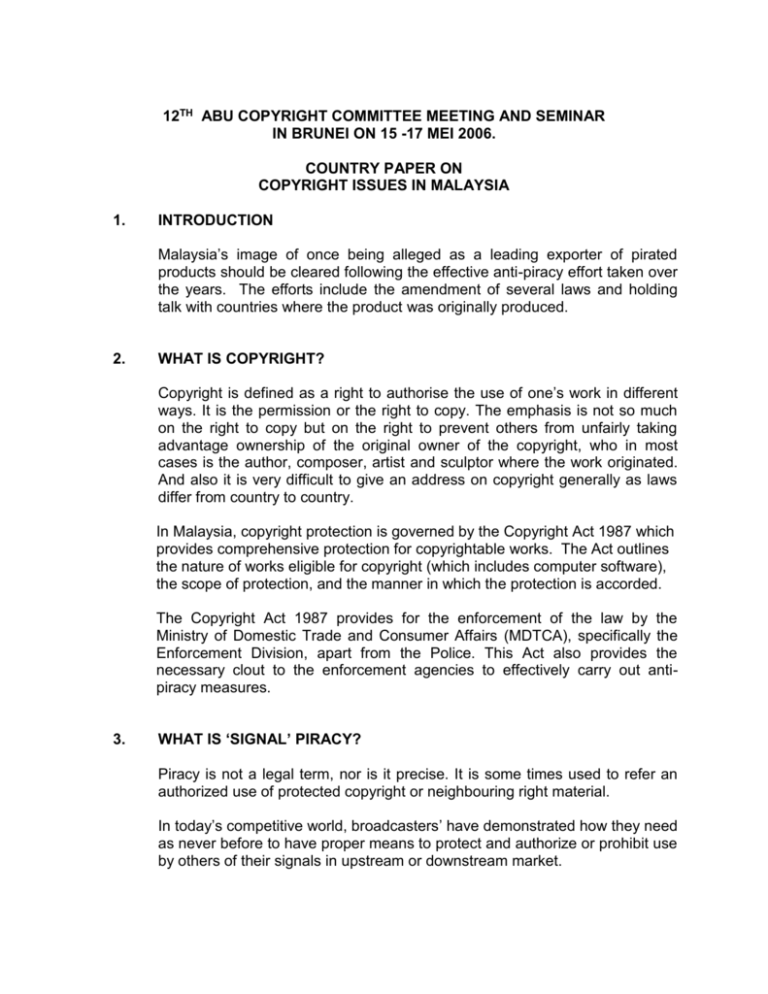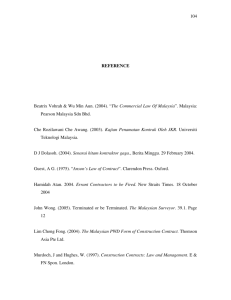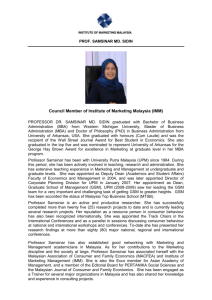copyright issues in malaysia
advertisement

12TH ABU COPYRIGHT COMMITTEE MEETING AND SEMINAR IN BRUNEI ON 15 -17 MEI 2006. COUNTRY PAPER ON COPYRIGHT ISSUES IN MALAYSIA 1. INTRODUCTION Malaysia’s image of once being alleged as a leading exporter of pirated products should be cleared following the effective anti-piracy effort taken over the years. The efforts include the amendment of several laws and holding talk with countries where the product was originally produced. 2. WHAT IS COPYRIGHT? Copyright is defined as a right to authorise the use of one’s work in different ways. It is the permission or the right to copy. The emphasis is not so much on the right to copy but on the right to prevent others from unfairly taking advantage ownership of the original owner of the copyright, who in most cases is the author, composer, artist and sculptor where the work originated. And also it is very difficult to give an address on copyright generally as laws differ from country to country. In Malaysia, copyright protection is governed by the Copyright Act 1987 which provides comprehensive protection for copyrightable works. The Act outlines the nature of works eligible for copyright (which includes computer software), the scope of protection, and the manner in which the protection is accorded. The Copyright Act 1987 provides for the enforcement of the law by the Ministry of Domestic Trade and Consumer Affairs (MDTCA), specifically the Enforcement Division, apart from the Police. This Act also provides the necessary clout to the enforcement agencies to effectively carry out antipiracy measures. 3. WHAT IS ‘SIGNAL’ PIRACY? Piracy is not a legal term, nor is it precise. It is some times used to refer an authorized use of protected copyright or neighbouring right material. In today’s competitive world, broadcasters’ have demonstrated how they need as never before to have proper means to protect and authorize or prohibit use by others of their signals in upstream or downstream market. Continued provision by broadcasters’ of programming to ensure a contentrich Information Society, including information for the general public on facts and events from all spheres of public life, is endangered as long as protection of signal is insufficient. In 1996 the WIPO Copyright Treaty (WCT) and WIPO Performances and Phonograms Treaty (WPPT) updated rights of authors, as well as performers and producers of phonograms. Since then, thorough discussion on upholding broadcasters’ right has taken place in 11 sessions of the WIPO Standing Committee on Copyright and Related Rights (SCCR) and in regional consultations. Over 7 years, more than 10 governments from both the developed and developing countries in different parts of the world have submitted proposed treaty texts for discussion. The overwhelming majority of government agree that it is now high time to adopt a new Treaty to update broadcasters’ protection. 4. LATEST DEVELOPMENT IN MALAYSIA’S COPYRIGHT LAW Spurred by a desire to enhance the attractiveness of its Multimedia Super Corridor (MSC) to high-tech investments, Malaysia has already taken a number of steps toward updating its copyright laws to meet the challenges of the internet era. In response to the explosion of the internet industry, The Malaysian Copyright Act 1987 was replaced by the Copyright Act 1997 which came into force on the 1st April 1999. The provision of the new Act makes unauthorised transmission of copyright works over the Internet and infringement of copyright. As for the definition of the literary work, it now includes table of compilations “whether or not expressed in words, figures of symbols and whether or not in a visible form”. The amended Act encompasses some of the standards contained in the WCT and the WPPT, such as recognizing the copyright owner’s exclusive rights to control work that is transmitted via wire or wireless means to the public, including making available this work to the public in such a way that members of the public may access the work from a place and at a time individually chosen by them. This Act certainly would help to overcome any effective technological measures aimed at restricting access to work, removal or alteration of any electronics rights management information without authority, or distribution, importation for distribution or communication to the public, without authority, works or copies of works in respect of which electronic rights management information has been removed or altered without authority. All in all, the new Act make it clear that an author has the right to be identified and has moral right against any mutilation and distortion of his work. These provisions are aimed at ensuring adequate protection of intellectual property rights for companies investing in the IT and multimedia environment. 5. COURT DISCUSSION AND PENDING CASES ON COPYRIGHT . A new recorded case on the copyright would be the lawsuit by the Recording Industry Association of Malaysia against a shopping complex in the central of Pahang for renting out it’s premised to VCD pirates. To win conviction against the culprit in court, for example, an offender was fined RM7.3 million besides ordered to serve a three year jail sentence in January last year. In one of the raids conducted by the enforcement officers, 31 computers and 211 copies of suspected unlicensed software from five companies were seized. If found guilty in a court of law the directors could face jail terms up to five years, on top of a possible fine of anywhere between RM2,000.00 to RM20,000.00 for each infringing software. In December 1998 Sun Movie sued against US Motion Pictures. Section 2 of Malaysia’s Copyright Act held that a different on ownership and copyright must be executed by the representative of the company. It is very costly to bring a witness from US to give live testimony and it was a threat to MDTCA. This case is still pending. Besides this, in May 1999, the local recording association filed a case against Sony Music Entertainment vs Wilayah Computer. MDTCA agreed to allow test cases to be filed in which claims of subsistence of ownership of copyright would be based on affidavits filed by the local anti-piracy agent of US Films Studios. This test case is still pending. 6. OTHER COPYRIGHT ISSUES The looming unauthorised copyrighted materials has made headlines and tainted the intellectual property industry. Due to this in 1999, Malaysian political leader denounced optical media piracy, and enforcement authorities mobilised to conduct and active programme of raiding retailers and other vendors of pirate products within the country. In his speech addressing a roundtable talk on Intellectual Property Rights Co-operation between Malaysia and United States in Kuala Lumpur on 20 April 2006, the Domestic Trade and Consumer Affairs Ministry (MDTCA), Datuk Mohd Shafie Apdal said efforts are taken to amend several laws and holding talks with countries where the products were originally produced. This he said should be able to clear Malaysia’s image of once being alleged as a leading exporter of pirated products. This is continued by holding discussions with countries like Hong Kong and some ASEAN countries on ways to overcome the influx of such products in this part of the region. Continued enforcement efforts my MDTCA had led to 1,175 anti-piracy cases under the Copyright Act 1987 to be recorded in 2005, compared to only 950 cases in 2004. An interagency task force under the direction of MDTCA launched “Ops Bungkus” to crack down on optical media piracy. By mid-January 2000, over 10,700 raids had been carried out by the task force throughout the country, with some operations involving more than 100 officers. On the retail level, large quantities of pirate product were seized, and the raids garnered widespread publicity. The Hologram sticker programme under the Trade Description (Original Label) Order 2002 of the Trade Descriptions Act 1972 (Act 82), which requires all distributors to pay for and apply stickers inside the shrinkwrap of all optical discs of copyrighted materials distributed in Malaysia has tremendously reduced the number of pirated materials. Another reform in the Copyright Act would be the amended Copyright Act 2003, Act A1195, which was enforced on August 14, 2003, whereby strengthened criminal penalties and generally gives enforcement authorities more ability to carry out enforcements against copyright piracy, for example Section 50A gives MDTCA officials the ability to carry out arrests for copyright piracy. The Malaysian Copyright Act provides for a Copyright Tribunal whose function is to grant Licenses to produce and publish in the National Language a translation of a literary work written in any other language. The Act is currently amended to expand the power of the tribunal to include arbitration of disputes relating to use of copyright works. 7. CONCLUSION The raids by Malaysian enforcement agencies indicate the country’s stand to wipe out the widespread of copyrighted materials. One of the key indicators to this stand is the amendment of governing Copyright Laws and increasing number of filed cases. As said by Datuk Mohd Shafie Apdal in his continuing speech, while the government would continue to take the necessary steps to put an end to piracy and counterfeiting activities, he reminded (Intellectual Property) IP owners of their roles to protect their own products. “Take civil actions against the violators of your IP. The IP owners, not the government, are the immediate losers”. NAGASVARE KRISHNASAMY RTM MARKETING KUALA LUMPUR MALAYSIA.







